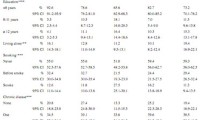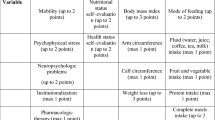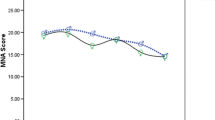Abstract
Objective
The study was to determine whether a modified MNA (Mini Nutritional Assessment) which adopted population-specific anthropometric cut-points but without BMI could maintain its predicting ability in community-living elderly in Taiwan.
Design
Purposive sampling.
Setting
Community-living elderly.
Participants
Three hundred and one (138 male and 163 female) >65-year-old outpatients seeking free annual health examination at an area hospital in central Taiwan.
Measurements
A structured questionnaire elicited personal data, lifestyle information and answers to the MNA. Laboratory results from health checkup provided the needed biochemical data. Each subject’s nutritional status was assessed with the MNA in three versions: the original, the MNA-TI (with population-specific cut-points), and the MNA-TII (further eliminated the BMI question and redistributed its score to the MAC and CC questions).
Results
All three versions identified the same 0.7% elderly malnourished. The proportions predicted at risk of malnutrition were 16.6, 12.0 and 10% according to the original, MNA-TI and MNA-TII, respectively. Friedman Test and post hoc analysis indicated that the pattern predicted by the original MNA was different from that predicted by the two modified versions whereas the patterns predicted by the two modified versions were not different from each other.
Conclusion
Adoption of population-specific anthropometric cut-points improves the predicting ability of the MNA in Taiwanese elderly, and the improved functionality is maintained in a version without BMI (but with adjusted MAC and CC scores). A MNA without BMI has greater applicability and can enhance professional efficiency of healthcare workers.
Similar content being viewed by others
References
Morely J.E., Silver A.J. Nutritional issues in nursing home care. Ann. Internal Med., 1995; 123: 850–859.
Copeman J. Promoting nutrition in older people in nursing and residential homes. Br. J. Comm. Nurs., 2000; 5: 277–284.
White J.V., Dwyer J.T., Posner B.M., et al. Nutrition Screening Initiative: Development and implementation of the public awareness checklist and screening tools. J. Am. Diet. Assoc., 1992; 92: 163–167.
Rush D. Evaluating the Nutrition Screening Initiative. Am. J. Pub. Health, 1993; 83: 94–95.
Kondrup J., Rsmuseen H.H., Hamberg O., Stanga Z., Ad Hoc ESPEN Working Group. Nutrition risk screening (NRS 2002): a new method based on an analysis of controlled clinical trials. Clin. Nutr., 2003; 22: 321–336.
Detsky A.S., McLaughlin J.R., Baker J.P., et al. What is Subjective Global Assessment of nutritional status? J. Parent. Ent. Nutr., 1987; 11: 8–13.
Guigoz Y., Vellas B.J., Garry P.J. The Mini Nutritional Assessment (MNA): A practical assessment tool for grading the nutritional state of elderly patients. In: Vellas BJ, Guigoz Y, Garry PJ, Albarede JL, eds. Facts and research in gerontology. Serdi Publishing Co., New York, NU. 1994 (Supplement: Nutrition); 15–60.
Guigoz Y., Lauque S., Villas B.J. Identifying the elderly at risk for malnutrition. The Mini Nutritional Assessment. Clin. Geriatr. Med., 2002; 18: 737–757.
Kuzuya M., Kanda S., Koike T., Suzuki Y., Satake S., Iguchi A. Evaluation of Mini-Nutritional Assessment for Japanese frail elderly. Nutrition, 2005; 21: 498–503.
Kruizenga H.M., Wierdsma N.J., van Bokhorst M.A., et al. Screening of nutrition status in the Netherlands. Clin. Nutr., 2003; 22: 147–152.
Saletti A., Lingdgren E.Y., Johansson L., Cederholm T. Nutritional status according to mini nutritional assessment in an institutionalized elderly population in Sweden. Gerontology, 2000; 46: 139–145.
Tsai A.C., Ho C.S., Chang M.C. Assessing the prevalence of malnutrition with the Mini Nutritional Assessment (MNA) in a nationally representative sample of elderly Taiwanese. J Nutr Health Aging, 2007;14: 51–55.
Tsai A.C., Ho C.S., Chang M.C. Population-specific anthropometric cut-points improve the functionality of the Mini Nutritional Assessment (MNA) in elderly Taiwanese. Asia Pac. J. Clin. Nutr., 2007; 16: 656–662.
Tsai A.C., Ku P.Y., Tsai J.D. Population-specific anthropometric cutoff standards improve the functionality of the Mini Nutritional Assessment without BMI in institutionalized elderly in Taiwan. J. Nutr. Health Aging, 2008; 12: 696–700.
Tsai A.C., Shih C.L. A population-specific Mini Nutritional Assessment can effectively grade the nutritional status of stroke rehabilitation patients in Taiwan. J. Clin. Nurs., 2008; 18: 82–88.
Tsai A.C., Ku P.Y. Population-specific Mini Nutritional Assessment effectively predicts the nutritional state and follow-up mortality of institutionalized elderly Taiwanese regardless of cognitive status. Br. J. Nutr., 2008; 100: 152–158.
Assessment of the hospitalized patient. In: Lee R.D., Nieman D.C., eds. Nutritional Assessment. Madison, WI: WCB Brown & Benchmark Publications, 1993; 165–191.
Woo J., Chumlea W.C., Sun S.S., et al. Development of the Chinese Nutrition Screen (CNS) for use in institutional settings. J. Nut. Health Aging, 2005; 9: 203–210.
Chumlea W.C. Is the MNA valid in different populations and across practice settings? J. Nut. Health Aging, 2006; 10: 524–533.
Allard J.P., Aghdassi E., McArthur M., et al. Nutrition risk factors for survival in the elderly living in Canadian Long-Term care facilities. JAGS 2004; 52: 59–65.
Charlton K.E., Kolbe-Alexander T.L., Nel J.H. Development of a novel nutrition screening tool for use in elderly South Africans. Public Health Nutr. 2005;8:468–479.
Chumlea W.C., Dwyer J., Bergen C., et al. Nutritional status assessed from anthropometric measures in the HEMO Study. J. Ren. Nutr. 2003, 13: 31–38.
Chumlea W.C. The state of the Mini Nutritional Assessment? Nutrition, 1999; 15: 159–161.
Author information
Authors and Affiliations
Corresponding author
Rights and permissions
About this article
Cite this article
Tsai, A.C., Chang, T.L., Yang, T.W. et al. A modified mini nutritional assessment without BMI predicts nsutritional status of community-living elderly in Taiwan. J Nutr Health Aging 14, 183–189 (2010). https://doi.org/10.1007/s12603-010-0046-5
Received:
Accepted:
Published:
Issue Date:
DOI: https://doi.org/10.1007/s12603-010-0046-5




